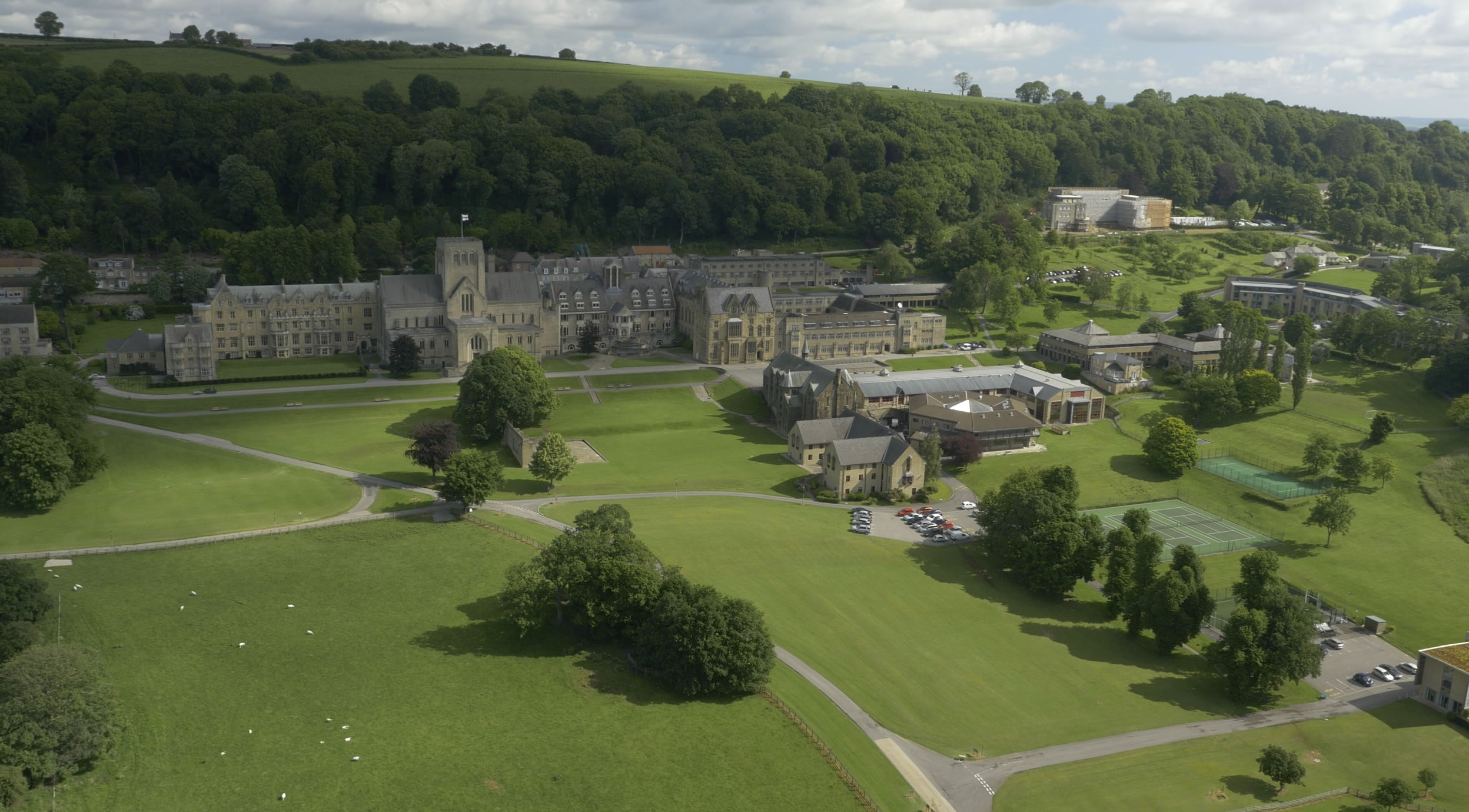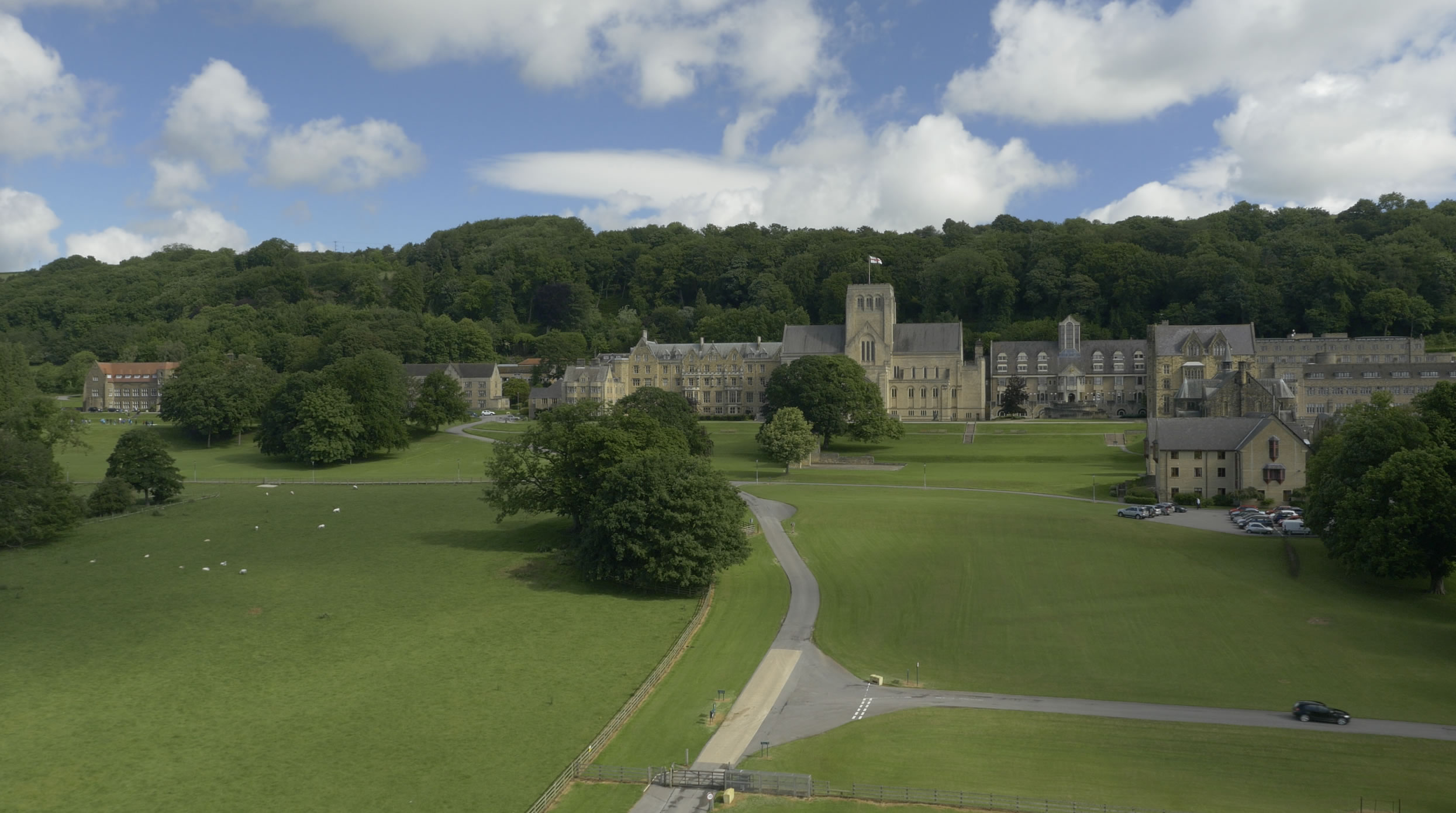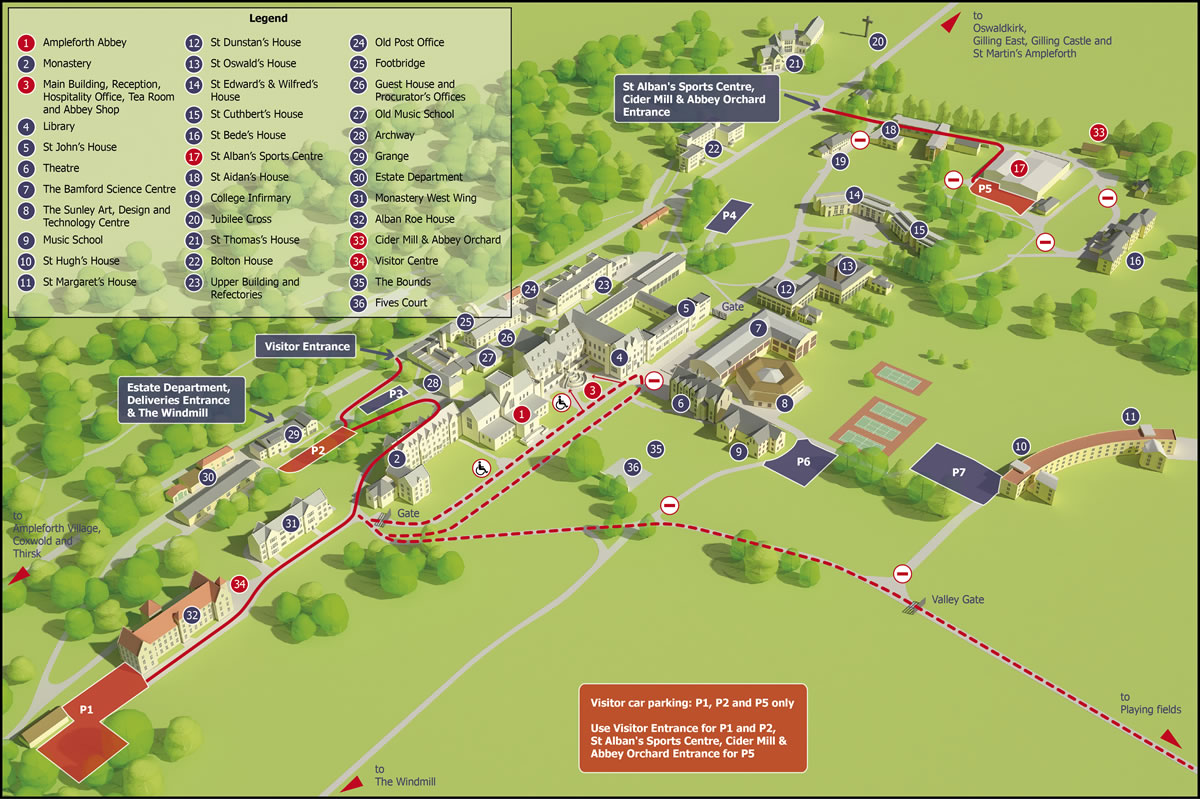Background



Long Description
Illustrative map of the Ampleforth Estate
- Ampleforth Abbey
- Monastery
- Main building, Reception, Hospitality Office, Tea Room and Abbey Shop
- Library
- St John's House
- Theatre
- The Bamford Science Centre
- The Sunley Art, Design and Technology Centre
- Music School
- St Hugh's House
- St Margaret's House
- St Dunstan's House
- St Oswalds House
- St Edward's and Wilfred's House
- St Cuthbert's House
- St Bede's House
- St Alban's Sports Centre
- St Aiden's House
- College Infirmary
- Jubilee Cross
- St Thomas's House
- Bolton House
- Upper Building and Refectories
- Old Post Office
- Footbridge
- Guest House and Procurator's Offices
- Old Music School
- Archway
- Grange
- Estate Department
- Monastery West Wing
- Alban Roe House
- Cider Mill and Abbey Orchard
- Visitor Centre
- The Bounds
- Fives Court

Long Description
- Chapter. All Solemnly Professed Monks
- Abbot
- Council. Senior monks who provide advice to the Abbot on monastic affairs
- The Ampleforth Abbey Trustees. The corporate trustee of the Ampleforth Abbey Trust and sole corporate member of SLET, SBT and Ampleforth Abbey Trading Ltd
- Nominations Committee. Advises on appointment to governing bodies and advisory committees
- Ampleforth Abbey Trust.
Holds all assets and controls subsidies
-
- St Laurence Education Trust (SLET)
- Ampleforth College
- St Martin's Ampleforth
- St Benet's Trust (SBT)
- St Benet's Hall
- Ampleforth Abbey Trading Ltd
- Commercial activities
- Safeguarding Commission. Established with the purpose of assisting, overseeing and advising with the regard to issues pertaining to the protection of the children and vulnerable adults
- Health and Safety Core Committee. Established with a strategic role in the planning, delivery, monitoring and review of the health and safety arrangements of the Ampleforth Abbey Trust
- Finance and General Purposes. Advises Ampleforth Abbey Trust across the broad range of its works
- Audit and Risk Management Committee
- Investment Committee
- Property Committee
- Communications Committee
-
Chronology of abbots, priors and headmasters
| Abbots of Ampleforth Abbey | |
|---|---|
| Abbot Herbert Byrne | 1939–1963 |
| Abbot Basil Hulme | 1963–1976 |
| Abbot Ambrose Griffiths | 1976–1984 |
| Abbot Patrick Barry | 1984–1997 |
| Abbot Timothy Wright | 1997–2005 |
| Abbot Cuthbert Madden | 2005–present[1] |
| Priors of Ampleforth Abbey | |
|---|---|
| Fr Justin Pryce | 1995–1997 |
| Fr George Corrie[2] | 1997–2005 |
| Fr Colin Battell | 2005–2011 |
| Fr Terence Richardson | 2011–2018 |
| Fr Gabriel Everitt | 2018–present |
| Headmasters of Ampleforth College | |
|---|---|
| Fr Patrick Barry | 1964–1979 |
| Fr Dominic Milroy | 1980–1991 |
| Fr Leo Chamberlain | 1992–2003 |
| Fr Gabriel Everitt | 2004–2014 |
| Mr David Lambon | 2014–2016 |
| Fr Wulstan Peterburs | June 2016–present |
| Gilling Castle Preparatory School (1930–1992/1993) | |
|---|---|
| Fr Hilary Barton | 1942–1965 |
| Fr William Price | 1965–1971 |
| Fr Justin Caldwell | 1971–1981 |
| Fr Adrian Convery | 1981–1987 |
| Graham Sasse | 1987–1993 |
| Ampleforth College Junior School (1993–2001) | |
|---|---|
| Fr Jeremy Sierla | 1993–2000 |
| John Hampshire | 2000–2001 |
| St Martin’s Ampleforth (2001–present) | |
|---|---|
| Stephen Mullen | 2001–2004 |
| Nicholas Higham | 2004–2014 |
| Mark O’Donnell | 2014–2016 |
| Dr David Moses | 2016–present |
Background
1. Ampleforth Abbey in Yorkshire is an English Benedictine monastery founded in 1802.[3] The monastery presently houses approximately 60–70 monks[4] who live in a community under the care of their abbot.
2. A chronological list of abbots, priors and headmasters of Ampleforth from 1939 to the present day is at the beginning of this section. The current abbot is Abbot Cuthbert Madden, who was elected on 15 February 2005 for an eight-year renewable term and re-elected on 12 February 2013. Abbot Cuthbert Madden, although remaining abbot in name, stepped aside in August 2016,[5] due to allegations of child sexual abuse being made against him. His duties were delegated to his prior, Fr Terence Richardson. As a result, Abbot Cuthbert Madden was living away from the monastery at the time of our Inquiry hearings. We understand that the allegations have been investigated by North Yorkshire Police (NYP), who found that there was insufficient evidence, and the Salford Diocese. A further independent review concluded in March of this year. We understand that Abbot Cuthbert Madden will be returning to Ampleforth as abbot and that a prior administrator has been appointed to carry out the duties of abbot in the interim.
3. Ampleforth College is a boarding and day school situated adjacent to Ampleforth Abbey. It was established by the abbey as a boys’ school in 1803.[6] Girls were admitted into the sixth form in 2002, and St Margaret’s, a girls’ boarding house, was opened in 2004.[7] The school became fully co-educational in 2010,[8] and presently has approximately 600 pupils aged 13–19.[9] Fr Wulstan Peterburs has been the headmaster of Ampleforth College since 12 November 2016. He is also a trustee of the Ampleforth Abbey Trust (AAT) and the St Laurence Educational Trust[10] (SLET, discussed below) and a member of the abbot’s Council.[11]
4. In 1908, the monks of the abbey established a preparatory section of Ampleforth College for boys under the age of 14.[12] The monks later purchased Gilling Castle, situated approximately three miles from Ampleforth College,[13] and in 1930 the lower part of the preparatory section was moved there to form Gilling Castle Preparatory School. Pupils aged 12–13 years remained at Ampleforth College, in what became known as Junior House. The preparatory school remained split until 1974, when it was decided to give Gilling its own top two years and allow boys to stay there until they moved to Ampleforth College. At the same time, the junior house was expanded, taking pupils from the age of 11. There were therefore two separate preparatory schools for Ampleforth College, one within Gilling Castle and one within Ampleforth College.
5. In 1992, the two preparatory schools were merged to form the Ampleforth College Junior School.[14] In 2001, Ampleforth College Junior School merged with St Martin’s, a small preparatory school eight miles away in Nawton, becoming St Martin’s Ampleforth (SMA).[15] SMA is now located at Gilling Castle and is the preparatory school for Ampleforth College.[16] It is also a boarding and a day school. It currently has capacity for 177 pupils aged three to 13.[17] Dr David Moses has been the headmaster of SMA since September 2016.[18] We understand that SMA will permanently close at the end of the 2018 summer term, to be replaced by a new junior house at Ampleforth College for boarding and day pupils in years 6, 7 and 8.[19]
6. As can be seen from the map, the senior school Ampleforth College is situated within the precincts of the abbey. Although Ampleforth College and SMA are on separate sites, they share the 2,200 acres of woodland, orchards and playing fields that belong to the abbey.[20] In addition to this geographical association between schools and the abbey, monks from the abbey may serve as teachers and chaplains,[21] and may lead religious services in schools.[22] As of November 2017, the number of monastic teaching staff employed at Ampleforth College was 12 (out of 106)[23] and at SMA was five (out of 90).[24]
7. Several witnesses have referred to Ampleforth College and SMA collectively as ‘the school’. Some have referred to the abbey and schools separately or collectively simply as ‘Ampleforth’. We will adopt the same approach, but will distinguish between them where necessary, and when dealing with allegations.